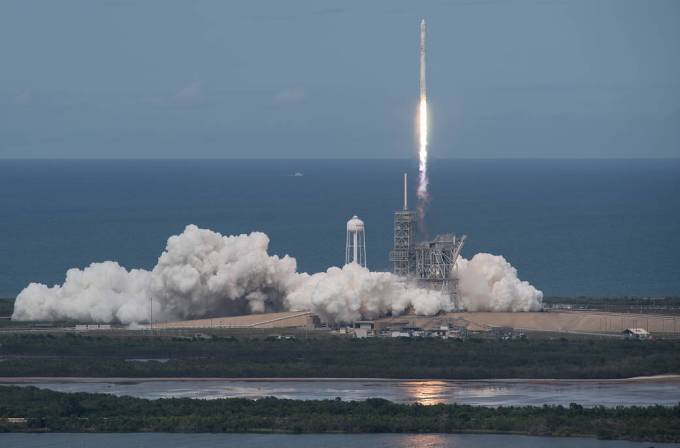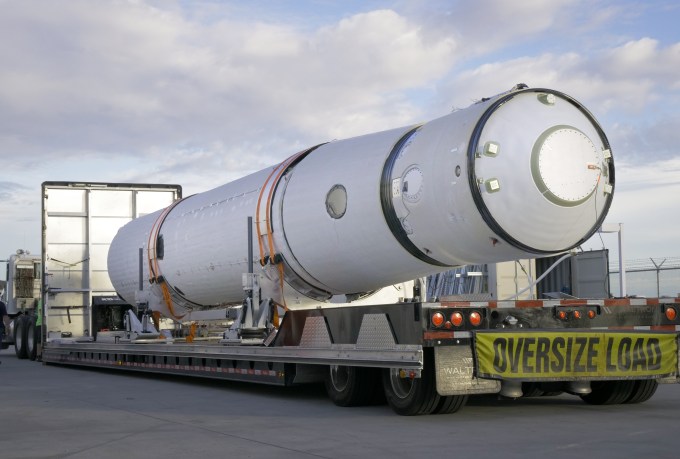In 1977, NASA sent the Voyager 1 spacecraft out on a mission to the distant worlds of our solar system.
Nestled safely aboard the spacecraft sits the Golden Record, a collection of sounds and songs of Earth meticulously chosen by scientists to repres…
Category: Space
SpaceX adds $100 million to previous $350 million funding round
 SpaceX filed a new amended update to its $351 million funding round from this summer, adding around $100 million to the round in newly disclosed funds and bringing the total to $450 million. The new follow-on funding puts SpaceX’s total post-money valuation at $21.5 billion. SpaceX spokesperson James Gleeson provided the following statement regarding the amended filing: “This… Read More
SpaceX filed a new amended update to its $351 million funding round from this summer, adding around $100 million to the round in newly disclosed funds and bringing the total to $450 million. The new follow-on funding puts SpaceX’s total post-money valuation at $21.5 billion. SpaceX spokesperson James Gleeson provided the following statement regarding the amended filing: “This… Read More
NASA created a new chainmail tire that can transform its shape
NASA Glenn Research Center has just reinvented the wheel, introducing a new tire that can get back to its original shape after having undergone deformation. This invention was possible thanks to a shape memory alloy based on nickel-titanium.
No…
Light pollution has worsened worldwide in last 5 years, with LED lights implicated
People are losing their view of the night sky all across the globe.
A sweeping new study analyzing five years of satellite data reveals that nights are growing brighter around the world as cities switch to more energy efficient LEDs.
The …
NASA says goodbye to Saturn with dramatic new photo
NASA is saying goodbye to Saturn with a newly-processed photo of the ringed planet taken during the last day of the Cassini mission.
The photo shows Saturn in all its sunlit glory, glowing gold against the blackness of space.
Cassini snap…
Another thing we thought was water on Mars actually isn’t water
/https%3A%2F%2Fblueprint-api-production.s3.amazonaws.com%2Fuploads%2Fcard%2Fimage%2F656088%2F638d60d0-b96c-4069-88d5-2a5da5e1e1cd.jpg)
Back in 2011, NASA scientists announced they had spotted compelling evidence that water sometimes still flowed on Mars. Now, researchers are backpedaling on these watery conclusions.
To NASA’s credit, the 2011 evidence looked quite convincing. Images captured by the Mars Reconnaissance Orbiter — a NASA satellite orbiting Mars — showed telltale dark streaks running down various mountains, valleys, and craters on Mars. They look strikingly similar to features formed on Earth’s surface by flowing water.
But, according to a new study in the journal Nature Geoscience, it turns out these dark streaks are made mostly of “granular flow” — sand and perhaps rocks falling downhill — rather than water flowing down valleys during the warmer Martian summers. Read more…
More about Space, Nasa, Science, Mars, and Mars Orbiter
View More Another thing we thought was water on Mars actually isn’t waterAn interstellar asteroid has been studied for the 1st time… and it looks really odd
In October, astronomers using a powerful telescope in Hawaii caught sight of something they’d never seen before: an asteroid from interstellar space hurtling through our solar system.
Now, about a month later, we have some sense of what that fa…
This is what a meteor looks like from space
/https%3A%2F%2Fblueprint-api-production.s3.amazonaws.com%2Fuploads%2Fcard%2Fimage%2F654411%2F03f57b3d-f401-4976-8984-bf6737a3800c.png)
You can see a lot of amazing things from space.
Astronauts on the International Space Station have spotted auroras dancing above Earth, menacing thunderstorms, destructive hurricanes, and just this month a European astronaut on the Space Station caught sight of a meteor shooting through the Earth’s atmosphere.
European Space Agency (ESA) astronaut Paolo Nespoli managed to catch the fireball falling to Earth in a time-lapse video on November 5.
And here a closer look! Make a wish… I already did 😉 // E qui visto da più vicino! Esprimete un desiderio… Io l’ho già fatto 😉 #VITAmission pic.twitter.com/H0q5f8hUG9
— Paolo Nespoli (@astro_paolo) November 16, 2017 Read more…
More about Space, Science, International Space Station, Meteors, and Meteor Shower
View More This is what a meteor looks like from spaceFireballs shoot across sky as Leonid meteor shower peaks
/https%3A%2F%2Fblueprint-api-production.s3.amazonaws.com%2Fuploads%2Fcard%2Fimage%2F654615%2Fecc40d31-3c76-4f85-b218-1825f75fc44a.jpg)
The Leonids meteor shower has been active for the past two weeks and this weekend the cosmic debris show is hitting its peak.
Leonids, named for the constellation Leo where the shower appears to originate from, started earlier this month and should give something of a show over the next few days. It’s true peak appeared to be Friday morning — early. It will continue until the beginning of December.
Already some impressive displays have lit up the night sky. This particular meteor shower occurs when crossing the debris of Comet Temple/Tuttle, which orbits the sun every 33 years. Read more…
More about Space, Science, Astronomy, Meteors, and Meteor Shower
View More Fireballs shoot across sky as Leonid meteor shower peaksThis isn’t the first time Elon Musk made big promises
He unveiled the Roadster 2 and the Semi Truck but people were underwhelmed. This isn’t the first time he’s done this. Remember the Tesla Model 3 production, Gigafactory, and Falcon Heavy launch?
Let’s just hope he’s finally worked out the kinks. Read…
Burton’s U.S. Winter Olympic uniforms are very old-school NASA
If you love snowboarding and you’re a space nerd the 2018 Winter Olympics are for you.
Burton Snowboards released the official U.S. snowboard team uniforms for the upcoming Winter Olympics in Pyeongchang, South Korea, and guess what: They’…
US Department of Defense books a test flight with Virgin Orbit’s LauncherOne
 The U.S. Department of Defense has booked a prototype flight on Virgin Orbit’s LauncherOne to demonstrate the capabilities of the company’s Low Earth Orbit launch service, Virgin Orbit said today. Read More
The U.S. Department of Defense has booked a prototype flight on Virgin Orbit’s LauncherOne to demonstrate the capabilities of the company’s Low Earth Orbit launch service, Virgin Orbit said today. Read More

